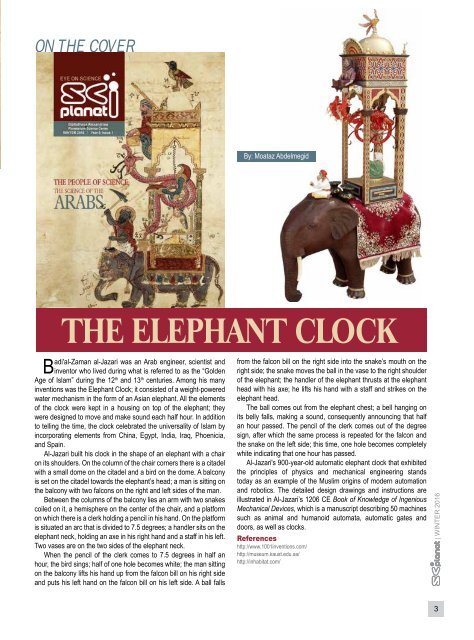ARABS
7eM8kM
7eM8kM
Create successful ePaper yourself
Turn your PDF publications into a flip-book with our unique Google optimized e-Paper software.
ON THE COVER<br />
By: Moataz Abdelmegid<br />
THE ELEPHANT CLOCK<br />
Badi'al-Zaman al-Jazari was an Arab engineer, scientist and<br />
inventor who lived during what is referred to as the “Golden<br />
Age of Islam” during the 12 th and 13 th centuries. Among his many<br />
inventions was the Elephant Clock; it consisted of a weight-powered<br />
water mechanism in the form of an Asian elephant. All the elements<br />
of the clock were kept in a housing on top of the elephant; they<br />
were designed to move and make sound each half hour. In addition<br />
to telling the time, the clock celebrated the universality of Islam by<br />
incorporating elements from China, Egypt, India, Iraq, Phoenicia,<br />
and Spain.<br />
Al-Jazari built his clock in the shape of an elephant with a chair<br />
on its shoulders. On the column of the chair corners there is a citadel<br />
with a small dome on the citadel and a bird on the dome. A balcony<br />
is set on the citadel towards the elephant’s head; a man is sitting on<br />
the balcony with two falcons on the right and left sides of the man.<br />
Between the columns of the balcony lies an arm with two snakes<br />
coiled on it, a hemisphere on the center of the chair, and a platform<br />
on which there is a clerk holding a pencil in his hand. On the platform<br />
is situated an arc that is divided to 7.5 degrees; a handler sits on the<br />
elephant neck, holding an axe in his right hand and a staff in his left.<br />
Two vases are on the two sides of the elephant neck.<br />
When the pencil of the clerk comes to 7.5 degrees in half an<br />
hour, the bird sings; half of one hole becomes white; the man sitting<br />
on the balcony lifts his hand up from the falcon bill on his right side<br />
and puts his left hand on the falcon bill on his left side. A ball falls<br />
from the falcon bill on the right side into the snake’s mouth on the<br />
right side; the snake moves the ball in the vase to the right shoulder<br />
of the elephant; the handler of the elephant thrusts at the elephant<br />
head with his axe; he lifts his hand with a staff and strikes on the<br />
elephant head.<br />
The ball comes out from the elephant chest; a bell hanging on<br />
its belly falls, making a sound, consequently announcing that half<br />
an hour passed. The pencil of the clerk comes out of the degree<br />
sign, after which the same process is repeated for the falcon and<br />
the snake on the left side; this time, one hole becomes completely<br />
white indicating that one hour has passed.<br />
Al-Jazari's 900-year-old automatic elephant clock that exhibited<br />
the principles of physics and mechanical engineering stands<br />
today as an example of the Muslim origins of modern automation<br />
and robotics. The detailed design drawings and instructions are<br />
illustrated in Al-Jazari’s 1206 CE Book of Knowledge of Ingenious<br />
Mechanical Devices, which is a manuscript describing 50 machines<br />
such as animal and humanoid automata, automatic gates and<br />
doors, as well as clocks.<br />
References<br />
http://www.1001inventions.com/<br />
http://museum.kaust.edu.sa/<br />
http://inhabitat.com/<br />
| WINTER 2016<br />
3


